The point being to demonstrate how low in level the digital capture can work, to pick up real signal, and to give a perspective of how vastly different in levels the possibly meaningful sound information on this track is.In this case what's the point?
The quietest places on the map, like Yellowstone Park in Wyoming, have a background noise level of less than 20 decibels—a noise level similar to that of the areas before European colonization, according to Science.My home background noise level is below 15 dbA.
Ed have at it, I have lost interest.
Last edited:
Why make it worse if we can make it better. This is my point. 24bit is better than 16bit, and it was demonstrated on the real recording. Anyone can make his choice, please feel free to do so. Large scale between 128kbps mp3 and 24bits uncompressed. Same reasoning (inaudible to me, enough to me) may be applied on the whole scale. Each to each, my choice is highest resolution and lowest noise.
Many people use headphones again, today. And, noise and artifacts need to be really, really low as your ear is right up against the speaker while it produces music.
Too bad Waley doesnt live next door to me... what he could do with all these racks and shelves full of test equipment. Every few years I do a purge to make room for the next batch of instruments. I'm in that purge process now:
View attachment 483142
View attachment 483143
View attachment 483144
View attachment 483145
Making room for jitter testing and some other new items.
THx-RNMarsh
I am so sorry I don't live close to you.
I am so sorry I don't live close to you.
We would have a good time.
-Richard
More simple schematics:
What is the purpose of R1, R2, R3, R4 ?
To prevent positive bias of the JFETs ?
Patrick
Note that the notion of a (more) linear amp working in conjunction with a cruder one keeps being reinvented and declared as the ultimate. Devialet is one company that comes to mind.
Like the recent new Benchmark AHB2 amp. At least they have a more fancy name: 'The AHB2 uses THX-patented AAA™ technology'.
If you read the patent, it is current dumping with a modified bridge so that they can do without the L.
Jan
About microphonic of solid state devices, all the tests i had done reflected NADA, NOTHING, NIB, RIEN, QUE DALLE, DES CLOUS.
Apart bad welds, but it is a strange way to build a microphone.
With tubes, it is fun to try various tube bases on guitar amps and listen to the way it changes the sound ;-)
Your opinions ?
Due to their inner construction and the typical way of mounting, semiconductors do not compare in microphonics with tubes.
That said, semiconductor based circuits in their physical implementation can be microphonic.
Till I make a showcase, consider the above as hand waving
Every few years I do a purge to make room for the next batch of instruments. I'm in that purge process now:
Keep your qualifying neighbors (or visitors of the local ham fest) satisfied

If you read the patent, it is current dumping with a modified bridge so that they can do without the L.
What is the patent number Jan?
George
Why make it worse if we can make it better. This is my point. 24bit is better than 16bit, and it was demonstrated on the real recording. Anyone can make his choice, please feel free to do so. Large scale between 128kbps mp3 and 24bits uncompressed. Same reasoning (inaudible to me, enough to me) may be applied on the whole scale. Each to each, my choice is highest resolution and lowest noise.
And I guess eventually you'll be able to tell us all how many angels can dance on the head of a pin.
se
The occasion to tell-you that your contributions are greatly appreciated, PMA.No. I have recordings to confirm.
What is the patent number Jan?
George
There are two, US8004355 and US8421531. I would have attached them but the files are too large.
PAT2PDF - Free PDF copies of patents: Download and print! will get them for you.
Jan
Onwards in the jitter saga:
I did some measurements on the impact of digital source jitter on the analog output of my trusted DCX2496 crossover/ 6 channel DAC. This unit has been modded with a new Frank Oettle clock with low noise psu, my own analog active output stage and a linear power supply in lieu of the stock switcher.
I recorded the analog output with a 1kHz digital input signal with 0dB and -60dB level, and various types and levels of jitter.
See the attached. My conclusion: source input jitter does not have an impact on the analog output quality, as theory predicted. The analog output jitter related quality is determined by the jitter performance of the DAC clocking system. Up to a point - when I do increase jitter to 50nS pk-pk or so, the DCX gives up and outputs garbage.
Comments?
Jan
I did some measurements on the impact of digital source jitter on the analog output of my trusted DCX2496 crossover/ 6 channel DAC. This unit has been modded with a new Frank Oettle clock with low noise psu, my own analog active output stage and a linear power supply in lieu of the stock switcher.
I recorded the analog output with a 1kHz digital input signal with 0dB and -60dB level, and various types and levels of jitter.
See the attached. My conclusion: source input jitter does not have an impact on the analog output quality, as theory predicted. The analog output jitter related quality is determined by the jitter performance of the DAC clocking system. Up to a point - when I do increase jitter to 50nS pk-pk or so, the DCX gives up and outputs garbage.
Comments?
Jan
Attachments
-
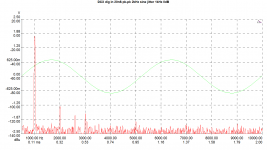 DCX 20nS pk-pk 2kHz sine jitter 1kHz 0dB dig in.png53.4 KB · Views: 202
DCX 20nS pk-pk 2kHz sine jitter 1kHz 0dB dig in.png53.4 KB · Views: 202 -
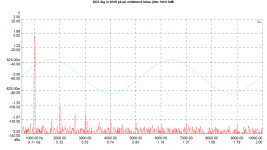 DCX 20nS pk-pk wideband noise jitter 1kHz 0dB dig in.png54.2 KB · Views: 192
DCX 20nS pk-pk wideband noise jitter 1kHz 0dB dig in.png54.2 KB · Views: 192 -
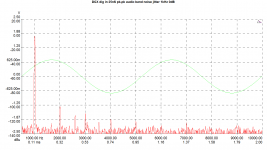 DCX 25nS pk-pk audioband noise jitter 1kHz 0dB dig in.png53.5 KB · Views: 183
DCX 25nS pk-pk audioband noise jitter 1kHz 0dB dig in.png53.5 KB · Views: 183 -
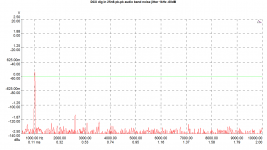 DCX 25nS pk-pk audioband noise jitter 1kHz -60dB dig in.png45.6 KB · Views: 181
DCX 25nS pk-pk audioband noise jitter 1kHz -60dB dig in.png45.6 KB · Views: 181 -
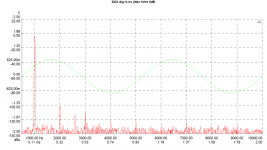 DCX no jitter 1kHz 0dB dig in.png52.6 KB · Views: 187
DCX no jitter 1kHz 0dB dig in.png52.6 KB · Views: 187 -
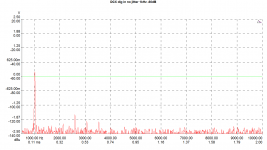 DCX no jitter 1kHz -60dB dig in.png45.4 KB · Views: 56
DCX no jitter 1kHz -60dB dig in.png45.4 KB · Views: 56
I should insist on 96KHz before....Why make it worse if we can make it better. This is my point. 24bit is better than 16bit, and it was demonstrated on the real recording.
Last edited:
Do you mind repeating the tests with full scale (ok, make it -0.5dBFS) test tone that is as close to the output FS/2 of the Behringer as practicable and, instead of showing h2; h3 etc; zoom in on the test tone to display sidebands and/or raising noise floor?I did some measurements on the impact of digital source jitter on the analog output of my trusted DCX2496 crossover/ 6 channel DAC.
...........
Comments?
Jan
Last edited:
Which of course has nothing to do with this.
Actually it does. The classic example of noting the exception.
The typical example is when you meet someone with a mole on their face your fixate and notice that because it is an exception to what you memory expects from a face. If everyone had moles then you wouldn't notice.
Once your mind has the model it tries to match everything close to that retained model. The example is that you can recognize a piece of music even if it is played with different instruments in a different key.
The more models you have learned the more you recognize.
"Somewhere in the middle" can be both simple / high performance (and a CFA) .
My answer will probably generate some controversy.
I noticed that complex assemblies (I mean things like Cascode, Super pairs, diamonds etc....) always help to reduce distortions or other evils. BUT they often add a "signature". I'm referring to Cascode, as the most obvious for me.
It is totally subjective, and hard to generalize. Well, totally subjective, not really, you can measure the changes. Added poles, increase of bandwidths etc.
To precise my question, i believe there is in everything (Distortion, noise, slew-rate), a blurred threshold where an improvement do not bring any benefit.
On the contrary, it seems to me than too complex amplifiers, with a lot of active devices lose details in music reproduction, compared to very simple ones.
Complicated question, implying to can figure out our thresholds (Like Richard said ;-), a little philosophical, with fashion or snake oil traces for pure objectivists, but i should be really happy to read as much 'opinions' as possible on this subject.
How far did-we have to go when we take decisions about topologies starting a power amp design ?
Last edited:
it seems to me than too complex amplifiers, with a lot of active devices lose details in music reproduction, compared to very simple ones.
Only when peeking.
No but he slept on a mattress clothes and all with no sheets for months
Standard issue. Even in female edition, with their entire wardrobe as sheets, I've slept on a couple of them.
(one had painted all her walls black, to write them with thoughts of the day. 2nd year medical student, she handed 2/3d of the dorm wing the crabs within six months. In my 1st year at tech-u, we had one who sold raw herring from a bucket in his room. He cleaned them on the table top he ate/studied at, bloke didn't own a cutting board/plate, or sheets, and his mattress looked dodgy)
Last edited:
Why make it worse if we can make it better.
Not the point, though I would like to see some background noise data from real commercial 24bit recordings. So sorry I don't like closed headphones and it's not worth it to me to treat a room to put the ambient noise low enough.
An Anechoic Chamber for SPCR
After more than two solid weeks of grunt work, the window had been blocked, the outer wall built up, the surface of the walls and ceiling covered with 600 lbs of blue fill, and a second door installed to improve the soundproofing around the entry: In essence, a small hemi-anechoic chamber. Total cost of all the materials ran around $4,000. It was time to assess what had been achieved acoustically...
... It typically measures 10~11 dBA through most of the day, although both ground and air traffic noise breaks through and occasionally registers over 20 dBA.
The anechoic chamber at Orfield laboratory in Minneapolis, MN is NIST certificate and was designed engineered and constructed by Eckel Industries. This chamber is "The quietest place on earth" according to the Guinness Book or World Records 2005. The ambient noise level was measured at -9.4dBA (typical chamber run 15 - 20 dBA).
- Status
- Not open for further replies.
- Home
- Member Areas
- The Lounge
- John Curl's Blowtorch preamplifier part II